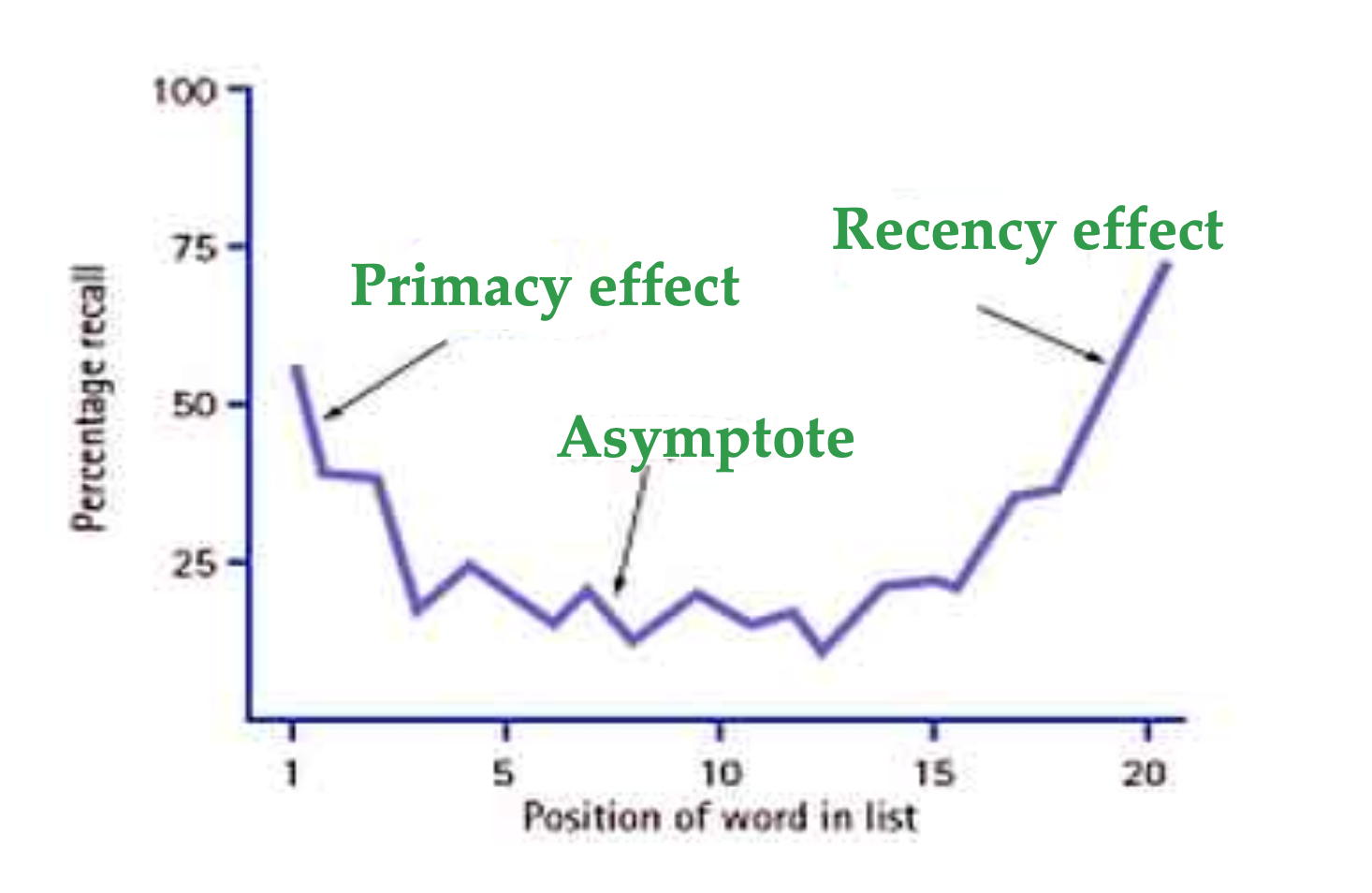Serial Position Effect
 The study of primacy and recency effect is evidence to support the separate STM and LTM stores that are part of Atkinson and Shiffrin's Multi-store Model. Unfortunately, there are several studies that are very similar and students often confuse the different studies on exams.
The study of primacy and recency effect is evidence to support the separate STM and LTM stores that are part of Atkinson and Shiffrin's Multi-store Model. Unfortunately, there are several studies that are very similar and students often confuse the different studies on exams.
You do not need to know all three versions below. If you are planning on using this study to support your response, be sure to learn one study well.
Atkinson and Shiffrin proposed the Multi-store Model of memory. In their model, short-term and long-term memory are separate stores. One of the ways in which the differentiation of these two stores has been shown is through experiments studying the Serial Position Effect.
The Serial Position Effect looks at two memory phenomena: the primacy and recency effect. When given a list of words, we tend to remember the words at the beginning and at the end of the list. The words at the beginning of the list are remembered because of the primacy effect - that is, we have had time to acoustically rehearse these words, allowing them to move into the long-term memory store.

Words from the end of the list are remembered because of the recency effect - that is, they are still in the short-term memory store and have not yet been displaced by other information.
The words in the middle of the list did not have enough time to be acoustically rehearsed so they were displaced from short-term memory. When looking at the curve, this is the flat area in the middle - referred to as an asymptote.
The following studies all study the serial position effect using different procedures.
Murdock's classic study is usually identified as the one that defined the serial position effect in the linear presentation of information.
The sample consisted of 103 introductory psychology students. The aim of the study was to see if the length of a list of words and/or the pace at which the words were read would have an effect on the serial position curve. The study used an independent samples design.
Participants were randomly allocated to one of six conditions. In three of the conditions, the words were read at a pace of one word per second. In the other three conditions, the words were read at a pace of one word every two seconds.
The conditions were as follows:
- 20 words read at one-second intervals (20 - 1)
- 30 words read at one-second intervals (30 - 1)
- 40 words read at one-second intervals (40 - 1)
- 10 words read at two-second intervals (10 - 2)
- 15 words read at two-second intervals (15 - 2)
- 20 words read at two-second intervals (20 - 2)
Each group was read 80 lists. The lists were constructed by randomly selecting from the 4000 most commonly used English words. Homonyms were excluded. After each list was read, the participants were given 1.5 minutes to recall the words in any order. All groups were read 20 lists per session; there were four sessions, spaced between 2 and 7 days apart. For each participant, the mean number of words recalled was calculated. Although the practice effect did lead to a significant difference in performance over time, the biggest improvement was 1.13 words.
The pace of the presentation did not make a difference. There was no significant difference found, for example, between groups 10-2 and 20-1.
The study produced six different serial position curves. In all cases, the greatest number of words was recalled at the end of the list due to the recency effect. This was followed by the words at the beginning of the list. The asymptote was most obvious in the list of 40 words. In the 10-word list, the primacy and recency curves intersected and there was no asymptote. This is most likely due to the fact that we can hold 7 +/- 2 pieces of information in STM.
In this study, Glanzer and Cunitz wanted to see if the interval of time between words on a list would increase the number of words recalled at the start of the list. Since the longer interval would provide more time for rehearsal, they hypothesized that the primacy effect would be greater. In addition, they wanted to see if each word was read twice in succession, would this improve the overall recall of the list.
The sample was made up of 240 Army enlisted men. The study used an independent samples design. There were 40 men allocated to each of the following conditions:
- Each word read once at a 3-second rate
- Each word read twice in succession at a 3-second rate
- Each word read once at a 6-second rate
- Each word read twice in succession at a 6-second rate
- Each word read once at a 9-second rate
- Each word read twice in succession at a 9-second rate
Participants were first given two 5-word practice lists so that they could learn the procedure.
They then listened to recordings of eight 20-word lists. The lists were the same for each group, except with the variation of time and repetition. All words on the lists were common one-syllable words. After each list was read, the participants had two minutes to write down the words they recalled in any order. A bell was used to signal the end of each list.
The researchers found that the increased time interval between words led to an increase in the recall of all words in the list except for those at the end of the list. The effect of repetition on recall was limited to the 3-second rate. There was no significant effect on recall in the 6 or 9-second rates.
This study supports the theory that the primacy effect is the result of rehearsal. The increased time interval allowed for more rehearsal, leading to the greater overall recall of the list of words. However, as words in the STM were still available in working memory, there was no significant change in the frequency of recall.
In this study, Glanzer and Cunitz focused on the recency effect rather than on the primacy effect.
The participants were 46 army enlisted men. The study used a repeated measures design.
Participants were first given three 5-word practice lists so that they could learn the procedure.
Then they were shown 15 fifteen-word lists. The words were shown on a screen with a projector. The words were common one-syllable words. Each word was shown for 1 second with a 2-second interval between words. The experimenter read each word as it appeared.
When the list was done, the participants either saw a # or a number between 0 and 9. If they saw the #, the experimenter said "write" and they wrote down as many words as they could recall in any order. If they saw a number, then they were to start counting from that number until the experimenter said, "write." The Experimenter would either stop them after 10 seconds or after 30 seconds. To summarize, the conditions were:
- Immediate recall
- Delayed recall (10 seconds)
- Delayed recall (30 seconds)
All participants were tested individually. The order of the reading of the lists was randomized.
When asked for immediate recall, both primacy and recency effects were shown. With the 10-second distraction task, there was a significant reduction of the recency effect. In the 30-second delay condition, the researchers reported, "no trace" of the recency effect.
When evaluating these studies, you should consider the following:
- Did the researcher use repeated measures or an independent samples design? What are the strengths and limitations of this design?
- How artificial are these tasks? Why did the researchers make the choices they did when designing the procedure?
- How well has the researcher controlled for extraneous variables? Do these studies have strong internal validity?
- How might the choice of sample have affected the findings of the research?

 IB Docs (2) Team
IB Docs (2) Team
